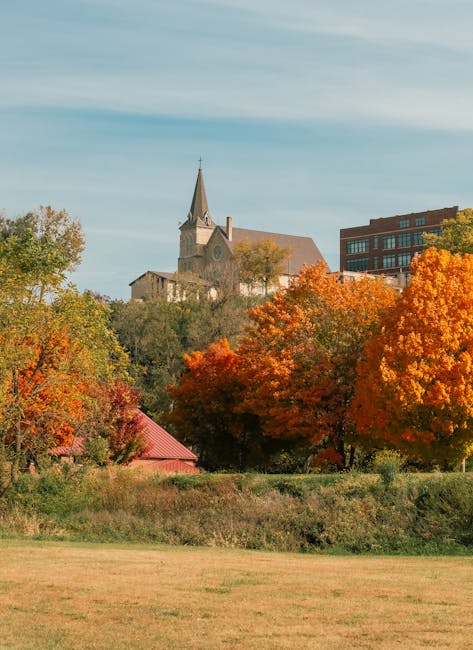Philadelphia’s Historic Churches: A Spiritual Journey
Philadelphia, the City of Brotherly Love, is a treasure trove of history and culture. Among its many attractions, the city’s historic churches stand out as remarkable landmarks that offer a glimpse into the past while providing spiritual nourishment for the present. Join us on a spiritual journey through Philadelphia’s historic churches, where history and faith intertwine.
The Significance of Historic Churches in Philadelphia
Philadelphia’s historic churches are more than just architectural marvels; they are testaments to the city’s rich cultural and spiritual heritage. These sacred spaces have witnessed centuries of change and have played pivotal roles in the lives of countless individuals. Here, we explore the importance of these historic churches and what makes them unique.
Architectural Beauty and Historical Significance
Many of Philadelphia’s historic churches boast stunning architectural beauty that captures the attention of both locals and tourists. These buildings often feature intricate designs, stained glass windows, and soaring spires that reflect the craftsmanship of bygone eras. Notable examples include:
- Christ Church: Known as the “Nation’s Church” due to its association with key figures from American history, including Benjamin Franklin and George Washington.
- Old St. Joseph’s Church: The oldest Catholic church in Philadelphia, established in 1733, with a rich history of serving the city’s immigrant communities.
- Mother Bethel A.M.E. Church: Founded by Richard Allen in 1794, it is the oldest African Methodist Episcopal church in the nation.
A Hub for Community and Faith
In addition to their architectural splendor, Philadelphia’s historic churches serve as vital hubs for community and faith. These sacred spaces have provided solace, support, and a sense of belonging to generations of worshipers. They continue to be active centers of worship and community service, offering programs that cater to the spiritual and social needs of their congregations.
Exploring Philadelphia’s Iconic Historic Churches
Now that we understand the significance of Philadelphia’s historic churches, let’s embark on a journey to explore some of the city’s most iconic sacred sites. Each church has its unique story and charm, making them must-visit destinations for history enthusiasts and spiritual seekers alike.
Christ Church: A National Treasure
Located in the heart of Old City, Christ Church is a national treasure that played a crucial role in American history. Founded in 1695, this Episcopal church is known for its Georgian architecture and historic significance. Visitors can explore the church’s interior, which features original pews, a stunning chandelier, and the graves of prominent figures such as Benjamin Franklin.

Christ Church is open for guided tours, allowing visitors to delve into its rich history. Don’t miss the chance to attend a service or special event to experience the church’s vibrant community firsthand.
Old St. Joseph’s Church: A Catholic Legacy
Established in 1733, Old St. Joseph’s Church holds the distinction of being the oldest Catholic church in Philadelphia. It played a pivotal role in the city’s Catholic history, serving as a sanctuary for immigrants and a center of faith. The church’s simple yet elegant design reflects its historical roots.

Visitors are welcome to attend Mass and explore the church’s serene interior. The parish also offers historical tours that delve into its fascinating past and contributions to the city’s Catholic community.
Mother Bethel A.M.E. Church: A Beacon of African American Heritage
Founded in 1794 by Richard Allen, Mother Bethel A.M.E. Church is a beacon of African American heritage and faith. This historic church, located in the Society Hill neighborhood, is the mother church of the African Methodist Episcopal denomination.

The church’s museum showcases artifacts and exhibits related to its rich history and the contributions of African Americans to the city’s religious and social fabric. Attending a service at Mother Bethel is a powerful experience that highlights the enduring spirit of its congregation.
Tips for Visiting Philadelphia’s Historic Churches
Planning a visit to Philadelphia’s historic churches can be a rewarding experience. Here are some actionable tips to make the most of your spiritual journey:
Research and Plan Ahead
Before visiting, research the specific churches you want to explore. Check their websites for information on visiting hours, guided tours, and any special events. Planning ahead ensures you make the most of your visit.
Respect Sacred Spaces
When visiting these historic churches, remember that they are active places of worship. Show respect by observing any posted guidelines, maintaining a quiet demeanor, and refraining from disruptive behavior.
Attend a Service
Attending a service at one of these historic churches can provide a deeper connection to their spiritual significance. Check the schedule for Mass, sermons, or special services and consider participating in one.
Explore Nearby Attractions
Philadelphia’s historic churches are often located near other notable attractions. Take the opportunity to explore the surrounding neighborhoods, which are rich in history, culture, and dining options.
Conclusion: Embracing Philadelphia’s Spiritual Heritage
Philadelphia’s historic churches are not just architectural marvels; they are living testaments to the city’s rich spiritual and cultural heritage. Exploring these sacred sites offers a unique opportunity to connect with the past while finding inspiration and solace in the present.
Whether you’re a history enthusiast, a spiritual seeker, or simply looking to experience the beauty of these historic churches, Philadelphia has something to offer. Plan your visit, immerse yourself in the stories of these iconic landmarks, and embrace the spiritual journey that awaits in the City of Brotherly Love.
Ready to embark on your spiritual journey through Philadelphia’s historic churches? Start planning your visit today and discover the timeless beauty and significance of these sacred spaces.
